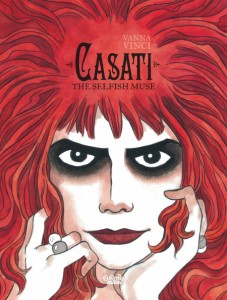 Casati: The Selfish Muse
Casati: The Selfish Muse
Vanna Vinci (writer and artist), Edward Gauvin (translator), Calix Ltd. (lettering)
Europe Comics
2015
Set during the Belle Epoque, throughout great European cities like London, Paris, Milan, Rome, and Venice, and featuring outstanding creators and creatives of the era? I had to get my hands on the digital graphic novel from Europe Comics, Casati: The Selfish Muse.
Casati is about Italian heiress Luisa Casati Amman, an eccentric, an aesthete, and a female dandy; a woman whose life goal was to be “a living work of art.” Born in 1881, Casati was known for walking leashed cheetahs in public , wearing snakes as jewelry, and even showing up for events with only gold dust to cover her body. She was unabashedly scandalous and thoroughly enjoyed spectacle. Casati, also known as simply The Marchesa, is an ideal subject and object for a graphic biography.
To briefly touch upon the numerous artists, from painters to poets, influenced by Casati: Cecil Beaton, Romaine Brooks, Colette, Jean Cocteau, Alastair Crowley, Isadora Duncan, Nijinsky, Augustus John, Jack Kerouac, Ezra Pound, Marcel Proust, Man Ray, Maurice Ravel, Tennessee Williams, and many, many more.
She also has had a lasting impact on couture fashion. She was a muse to both Paul Poiret and Charles Worth (the “father of haute couture”), and she influenced such female fashion designers as Coco Chanel, Elsa Schiaparelli, and Madeleine Vionnet. British fashion house Marchesa is named after her, and in more recent fashion history, she has inspired Christian Dior’s Spring/Summer 1998 collection and Alexander McQueen’s Spring/Summer 2007 collection.

However, despite her representation in art being comparable with that of the Virgin Mary and Cleopatra, history has largely ignored the Marchesa. Only three full-length biographies have been written about her. After all, a rich patroness seeking to be “a living work of art” can easily be diminished as frivolous and self-absorbed. Yet, the Marchesa had her own aesthetic preferences that influenced the art she patroned. She was known for powdering her face white, wearing thick kohl around her eyes, dilating her pupils with belladonna, and possessing an interest in the occult—she arguably pioneered goth as an aesthetic and even a lifestyle.
Vanna Vinci, Casati: The Selfish Muse’s author and illustrator, does not veer away from negative takes on the Marchesa, but embraces them as a celebration of a remarkable woman who defied the societal norms of her day and devoted her very soul to the pursuit of art. Instead of moralizing over Casati’s numerous affairs with both men and women, and her lack of maternity towards her sole child, Vinci depicts the Marchesa from the perspectives of the creatives she influenced. Isadora Duncan, Cecil Beaton, and many others of the time are given life as they speak directly to the reader about the Marchesa. In many ways, it feels like a documentary, but considering that these people are long dead, there’s an inventiveness to how Vinci breaks the fourth wall.

In the above panel, not only does the poet and writer Gabriele D’Annunzio talk about his impressions of the Marchesa, but the Marchesa also speaks up. Via her rendition of the Marchesa (Vinci took the many paintings and photographs of the Marchesa as a “departure point”), the biography becomes feminist. The Marchesa expresses her desires, and her lack thereof, without shame or guilt. In this way, Casati is as much an object in this book as she is a subject. Considering her direct influence in the art she patroned and the lives of the artists’ she supported, it only seems apt that she should be represented in this way. Overall, the Marchesa’s desire to be a living work of art is represented as a justifiable ambition, as well as the longing of a bored rich woman.
At one point, one of the Marchesa’s servants speaks directly to the reader about the degrading things they had to do to appease her eccentricity. This moment lends Vinci’s representation of the Casati complexity, but unfortunately, these types of moments are few and far between. The book’s tone is largely celebratory and lauding, but moments like these welcome a more complex and honest glimpse into the life of the Marchesa without veering into condemnation.

As this book is about an aesthete, the art is a visual treat that demonstrates Vinci’s knowledge of and appreciation for fashion as a communicative art form. The book opens showing Casati in 1950s London during the height of Dior’s New Look. Casati stands out as a derelict woman in a fur coat, the long lean lines of her tattered fur coat no longer the fashion in post-World War II Western Europe. Fashion silhouettes tell us a lot about the cultural and social environment of specific eras, and in the case of Casati, tell us much about the Marchesa’s character.
In the excerpt from page 11, Casati is decked out in turn of the century fashion – high-necked, restrictive, and constrictive. The popular S-bend, often associated with the Gibson Girl, abounds in the background of the entire comic, but by the next page, Casati is wearing lower necklines and less restrictive silhouettes, anticipating the rise in popularity of Paul Poiret’s designs that will eventually culminate in the silhouette of the flapper. Yet, even as this popular silhouette takes a turn from this to the cinched waist and exaggerated curves of the New Look, the Marchesa continues to done the long, lean lines and draping reminiscent of Poiret, indicating and reflecting her rejection of constricting and restricting societal norms.
Though at times Vinci could have pushed the tone of the book beyond mere celebration to something more nuanced, as she shows a skill for deftly balancing honesty without condemnation, Casati is a lovely addition to the fashion lover’s library. I wish this book wasn’t only in digital form as it makes for a great coffee table piece for the fashion geek.






